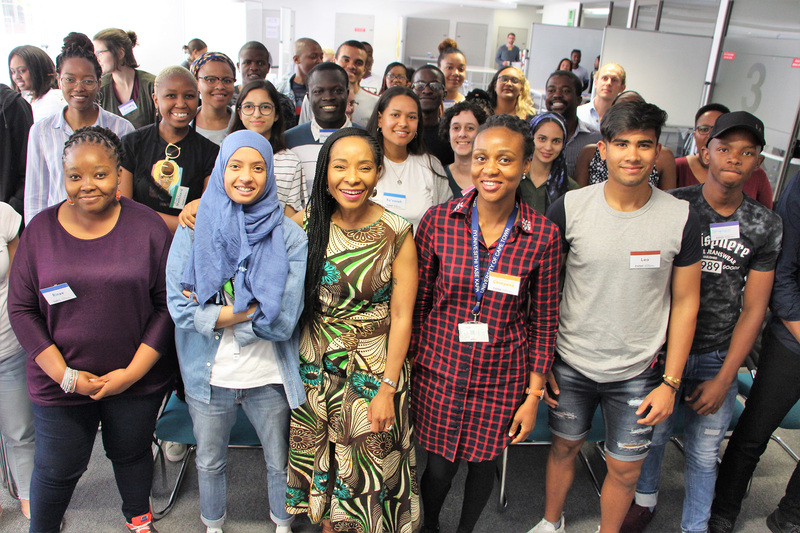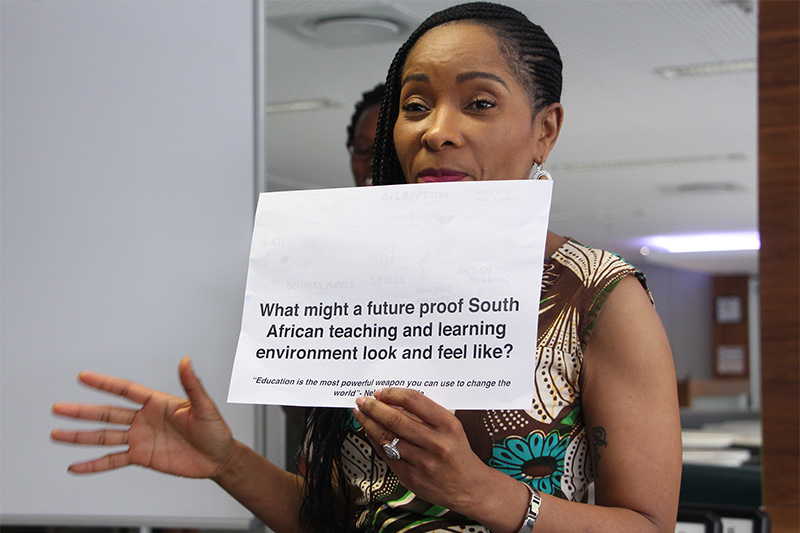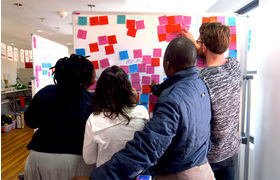Designing people-centred solutions
11 December 2018 | Story Carla Bernardo. Photos Yazeed Kamaldien. Read time 5 min.
Human-centred solutions to issues in the education sector were in the spotlight at the launch of the Hasso Plattner Institute of Design Thinking’s (d-school) fourth annual Design Thinking Week.
The launch saw 40 students from 11 of South Africa’s tertiary institutions gather at the University of Cape Town’s (UCT) Library Learning Lounge on Monday, 10 December.
Vice-Chancellor Professor Mamokgethi Phakeng officially opened the week, diving straight into the challenges faced by tertiary institutions, with a focus on UCT. She related these challenges to the university’s vision of securing a sustainable future that is inclusive, engaged and African.
To realise this vision, she said, it is critical to identify current and potential threats. These include the “shake-up” caused by the movements for, among others, decolonisation, the removal of statues, and shutdowns, all of which she described as important and necessary.
“With a shake-up, good things happen … rethinking happens. [But] with a shake-up, there are things that we are at risk of losing,” she said.
A space for ideas
For the university, which exists for the academic project, the risk of the shake-up is the loss of its space for ideas.
“University is a space for ideas. It is the only space where you don’t all have to agree on the same idea; you don’t have to think the same way, [or] do things the same way.”
But even African, Eastern and decolonial texts and thinkers must be critiqued or, said Phakeng, “we are at a risk in higher education of losing that space”.
“The d-school is a place that brings different people from different backgrounds together to tackle problems.”

This is one of the reasons she considers the role of the d-school, which receives funding, intellectual property (IP) and academic support from German businessman and philanthropist Professor Hasso Plattner, to be “critically important”.
“We imagine the d-school being a place where that space of ideas is enacted.”
Phakeng added that the d-school can bring diverse students together to tackle problems faced by both the higher and basic education sectors, as well as society at large. This includes addressing what a future UCT campus could look like and how it can better serve students.
Engaging the end user
The challenges she identified spoke directly to the one presented to the week’s participants. This was: “What might a future-proof South African teaching and learning environment look and feel like?”
Richard Perez, the d-school director, said that during the week the students work on a real-world challenge, usually pitched by industry, either the public or private sector.
“They then spend four days being exposed to the key mindsets and tools of design thinking as they go about solving the challenge.
“One of design thinking’s key attributes is to be human-centred and understand the needs of the users related to the challenge you are trying to address,” he explained.
“It is important for us to understand from young students what kind of future teaching and learning environment they would like to have.”
Programme manager Dr Keneilwe Munyai said participants will, through the teachings of design thinking, learn to fail early, fast and often, “so that they can quickly learn and not waste money and resources on a project that is not going to work”.
“The overarching consideration for the project is that it needs to incorporate the future of South Africa.”
The ideas and outcomes presented by participants at the end of the week are then fed into a brief for the d-school’s own building.
Jonathan Ray from KMH Architects, and d-school building project manager Neil Parker, were also on hand to engage with participants and hear about their needs and dreams for a design-thinking school.
For Parker, it is critical to have the input of all participating students from the 11 institutions.
“The overarching consideration for the project is that it needs to incorporate the future of South Africa,” he said.
The design process for the building, which will be located on middle campus, will begin in early 2019.
 This work is licensed under a Creative Commons Attribution-NoDerivatives 4.0 International License.
This work is licensed under a Creative Commons Attribution-NoDerivatives 4.0 International License.
Please view the republishing articles page for more information.










